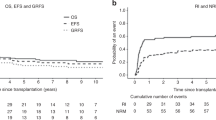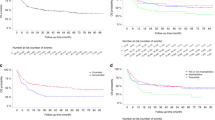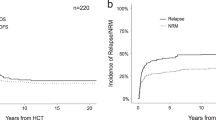Abstract
The outcome of patients with therapy-related myelodysplasia (t-MDS) or t-AML is very poor. The only curative treatment option implements allogeneic hematopoietic cell transplantation (aHCT); however, long-term follow-up data beyond 5 years are scarce. Here we report on a cohort of 79 consecutive patients with a median age of 58 years (range (r): 20–76) at transplantation and a median follow-up of 7.5 years (r: 0.07–19.0). Only 19 (24.1%) patients were in CR before aHCT. Non-relapse mortality and relapse rates were 23% (95% confidence interval, 15–35%) and 42% (32–55%) at 5 years, and 32% (22–46%) and 44% (34–57%) at 10 years, respectively. Disease-free survival (DFS) and overall survival (OS) rates were 35% (24–46%) and 38% (27–49%) at 5 years, and 24% (14–36%) and 24% (13–36%) at 10 years, respectively. Although cytogenetic aberrations were associated with shorter DFS and higher relapse risk, persistent disease at the time of transplantation, an unrelated donor and patient age were not associated with shorter OS. In conclusion, long-term survival beyond 10 years of t-MDS/t-AML patients after aHCT is possible, even for refractory patients. Therefore, early donor search and rapid transplantation are warranted, also to decrease the risk of disease-related deterioration of patients’ performance status.
This is a preview of subscription content, access via your institution
Access options
Subscribe to this journal
Receive 12 print issues and online access
$259.00 per year
only $21.58 per issue
Buy this article
- Purchase on Springer Link
- Instant access to full article PDF
Prices may be subject to local taxes which are calculated during checkout


Similar content being viewed by others
References
Levine EG, Bloomfield CD . Secondary myelodysplastic syndromes and leukaemias. Clin Haematol 1986; 15: 1037–1080.
Borthakur G, Estey AE . Therapy-related acute myelogenous leukemia and myelodysplastic syndrome. Curr Oncol Rep 2007; 9: 373–377.
Kushner BH, Kramer K, Modak S, Qin LX, Yataghena K, Jhanwar SC et al. Reduced risk of secondary leukemia with fewer cycles of dose-intensive induction chemotherapy in patients with neuroblastoma. Pediatr Blood Cancer 2009; 53: 17–22.
Howe R, Micallef IN, Inwards DJ, Ansell SM, Dewald GW, Dispenzieri A et al. Secondary myelodysplastic syndrome and acute myelogenous leukemia are significant complications following autologous stem cell transplantation for lymphoma. Bone Marrow Transplant 2003; 32: 317–324.
Armand P, Kim HT, DeAngelo DJ, Ho VT, Cutler CS, Stone RM et al. Impact of cytogenetics on outcome of de novo and therapy-related AML and MDS after allogeneic transplantation. Biol Blood Marrow Transplant 2007; 13: 655–664.
Litzow MR, Tarima S, Pérez WS, Bolwell BJ, Cairo MS, Camitta BM et al. Allogeneic transplantation for therapy-related myelodysplastic syndrome and acute myeloid leukemia. Blood 2010; 115: 1850–1857.
Kröger N, Brand R, van Biezen A, Zander A, Dierlamm J, Niederwieser D et al. Risk factors for therapy-related myelodysplastic syndrome and acute myeloid leukemia treated with allogeneic stem cell transplantation. Haematologica 2009; 94: 542–549.
Slovak ML, Kopecky KJ, Cassileth PA, Harrington DH, Theil KS, Mohamed A et al. Karyotypic analysis predicts outcome of preremission and postremission therapy in adult acute myeloid leukemia: a Southwest Oncology Group/Eastern Cooperative Oncology Group Study. Blood 2000; 96: 4075–4083.
Bertz H, Spyridonidis A, Wäsch R, Grüllich C, Egger M, Finke J . A novel GVHD-prophylaxis with low-dose alemtuzumab in allogeneic sibling or unrelated donor hematopoetic cell transplantation: the feasibility of deescalation. Biol Blood Marrow Transplant 2009; 15: 1563–1570.
Finke J, Bethge WA, Schmoor C, Ottinger HD, Stelljes M, Zander AR et al. Standard graft-versus-host disease prophylaxis with or without anti-T-cell globulin in haematopoietic cell transplantation from matched unrelated donors: a randomised, open-label, multicentre phase 3 trial. Lancet Oncol 2009; 10: 855–864.
Rowlings PA, Przepiorka D, Klein JP, Gale RP, Passweg JR, Henslee-Downey PJ et al. IBMTR Severity Index for grading acute graft-versus-host disease: retrospective comparison with Glucksberg grade. Br J Haematol 1997; 97: 855–864.
Shulman HM, Sullivan KM, Weiden PL, McDonald GB, Striker GE, Sale GE et al. Chronic graft-versus-host syndrome in man. A long-term clinicopathologic study of 20 Seattle patients. Am J Med 1980; 69: 204–217.
Yakoub-Agha I, de La Salmonière P, Ribaud P, Sutton L, Wattel E, Kuentz M et al. Allogeneic bone marrow transplantation for therapy-related myelodysplastic syndrome and acute myeloid leukemia: a long-term study of 70 patients-report of the French society of bone marrow transplantation. J Clin Oncol 2000; 18: 963–971.
Witherspoon RP, Deeg HJ, Storer B, Anasetti C, Storb R, Appelbaum FR . Hematopoietic stem-cell transplantation for treatment-related leukemia or myelodysplasia. J Clin Oncol 2001; 19: 2134–2141.
Armand P, Kim HT, Mayer E, Cutler CS, Ho VT, Koreth J et al. Outcome of allo-SCT for women with MDS or AML occurring after breast cancer therapy. Bone Marrow Transplant 2010; 45: 1611–1617.
Bhatia S . Therapy-related myelodysplasia and acute myeloid leukemia. Semin Oncol 2013; 40: 666–675.
Steinmann J, Bertz H, Wäsch R, Marks R, Zeiser R, Bogatyreva L et al. 5-Azacytidine and DLI can induce long-term remissions in AML patients relapsed after allograft. Bone Marrow Transplant 2015; 50: 690–695.
de Lima M, Giralt S, Thall PF, de Padua Silva L, Jones RB, Komanduri K et al. Maintenance therapy with low-dose azacitidine after allogeneic hematopoietic stem cell transplantation for recurrent acute myelogenous leukemia or myelodysplastic syndrome: a dose and schedule finding study. Cancer 2010; 116: 5420–5431.
Platzbecker U, Wermke M, Radke J, Oelschlaegel U, Seltmann F, Kiani A et al. Azacitidine for treatment of imminent relapse in MDS or AML patients after allogeneic HSCT: results of the RELAZA trial. Leukemia 2012; 26: 381–389.
Reikvam H, Kittang AO, Melve G, Mosevoll KA, Bentsen PT, Ersvær E et al. Targeted anti-leukemic therapy as disease-stabilizing treatment for acute myeloid leukemia relapse after allogeneic stem cell transplantation: Will it be possible to combine these strategies with retransplantation or donor lymphocyte infusions? Curr Cancer Drug Targets 2013; 13: 30–47.
Di Stasi A, Jimenez AM, Minagawa K, Al-Obaidi M, Rezvani K . Review of the results of WT1 peptide vaccination strategies for myelodysplastic syndromes and acute myeloid leukemia from nine different studies. Front Immunol 2015; 6: 36.
Schneider V, Zhang L, Rojewski M, Fekete N, Schrezenmeier H, Erle A et al. Leukemic progenitor cells are susceptible to targeting by stimulated cytotoxic T cells against immunogenic leukemia-associated antigens. Int J Cancer 2015; 137: 2083–2092.
Steger B, Milosevic S, Doessinger G, Reuther S, Liepert A, Braeu M et al. CD4(+)and CD8(+)T-cell reactions against leukemia-associated- or minor-histocompatibility-antigens in AML-patients after allogeneic SCT. Immunobiology 2014; 219: 247–260.
Cornelissen JJ, Breems D, van Putten WL, Gratwohl AA, Passweg JR, Pabst T et al. Comparative analysis of the value of allogeneic hematopoietic stem-cell transplantation in acute myeloid leukemia with monosomal karyotype versus other cytogenetic risk categories. J Clin Oncol 2012; 30: 2140–2146.
Lübbert M, Bertz H, Müller MJ, Finke J . When azanucleoside treatment can be curative: nonintensive bridging strategy before allografting in older patients with myelodysplastic syndrome/acute myeloid leukemia. J Clin Oncol 2013; 31: 822–823.
Ustun C, Lazarus HM, Weisdorf D . To transplant or not: a dilemma for treatment of elderly AML patients in the twenty-first century. Bone Marrow Transplant 2013; 48: 1497–1505.
Guo RJ, Atenafu EG, Craddock K, Chang H . Allogeneic hematopoietic cell transplantation may alleviate the negative prognostic impact of monosomal and complex karyotypes on patients with acute myeloid leukemia. Biol Blood Marrow Transplant 2014; 20: 690–695.
Li L, Li M, Sun C, Francisco L, Chakraborty S, Sabado M et al. Altered hematopoietic cell gene expression precedes development of therapy-related myelodysplasia/acute myeloid leukemia and identifies patients at risk. Cancer Cell 2011; 20: 591–605.
Servais S, Porcher R, Xhaard A, Robin M, Masson E, Larghero J et al. Pre-transplant prognostic factors of long-term survival after allogeneic peripheral blood stem cell transplantation with matched related/unrelated donors. Haematologica 2014; 99: 519–526.
Sorror M, Storer B, Sandmaier BM, Maloney DG, Chauncey TR, Langston A et al. Hematopoietic cell transplantation-comorbidity index and Karnofsky performance status are independent predictors of morbidity and mortality after allogeneic nonmyeloablative hematopoietic cell transplantation. Cancer 2008; 112: 1992–2001.
Acknowledgements
We wish to acknowledge E Lenartz for coordinating donor search, I Matt for data management and N Claus, S Enger and I Huber for technical assistance in the BMT laboratory. Moreover, we thank M Bentz, T Fietz, TS Fischer, A Jakob, J Mezger and W Brugger for patient referrals. Finally, we thank the nurses and fellows of the Löhr ward for their everyday dedication in treating our patients.
Author information
Authors and Affiliations
Corresponding author
Ethics declarations
Competing interests
The authors declare no conflict of interest. JF received research grants and speakers honoraries from Medac, Noevii Biotech, Novartis and Riemser.
Rights and permissions
About this article
Cite this article
Finke, J., Schmoor, C., Bertz, H. et al. Long-term follow-up of therapy-related myelodysplasia and AML patients treated with allogeneic hematopoietic cell transplantation. Bone Marrow Transplant 51, 771–777 (2016). https://doi.org/10.1038/bmt.2015.338
Received:
Revised:
Accepted:
Published:
Issue Date:
DOI: https://doi.org/10.1038/bmt.2015.338
This article is cited by
-
Factors predicting survival following alloSCT in patients with therapy-related AML and MDS: a multicenter study
Bone Marrow Transplantation (2023)
-
ELN risk stratification and outcomes in secondary and therapy-related AML patients consolidated with allogeneic stem cell transplantation
Bone Marrow Transplantation (2021)
-
Outcomes of pediatric patients with therapy-related myeloid neoplasms
Bone Marrow Transplantation (2021)
-
Allogeneic stem cell transplantation for non-de novo AML or advanced myelodysplastic syndromes: influence of GvHD and donor lymphocyte infusions on long-term outcome
Bone Marrow Transplantation (2018)
-
Geriatric assessment and quality of life in older patients considered for allogeneic hematopoietic cell transplantation: a prospective risk factor and serial assessment analysis
Bone Marrow Transplantation (2018)



